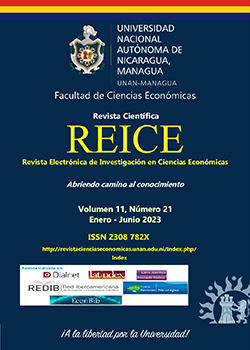Economic challenges of intellectual property in the digital era: legal, economic and social aspects
DOI:
https://doi.org/10.5377/reice.v11i21.16553Keywords:
intellectual property, political regimes, intellectual property protection, intellectual property rights, technology protectionAbstract
In the contemporary digital era, nations are engaged in active competition, not solely within the realms of economics, but also in the domain of technology, thus establishing a new paradigm of global power dynamics. Within this framework, the economic, legal, and social hurdles associated with safeguarding intellectual property (hereinafter IP) have witnessed a significant rise. This article aims to examine the economic challenges posed by intellectual property in the digital age, considering the backdrop of intensified global competition and the imperative to maintain national competitiveness across legal, economic, and social dimensions. The article employs a statistical analysis methodology, utilizing intellectual property data obtained from the World Intellectual Property Organization (WIPO) statistics database, specifically the WIPO IP Statistics Data Center. The authors examine cross-border payments and revenues associated with intellectual property exploitation in diverse nations. Furthermore, the study investigates the composition and dynamics of intellectual property across various types (such as patents, industrial designs, trademarks, and utility models) and regions, thereby facilitating an assessment of the competitive landscape and cooperative endeavors among the world's leading countries in the realm of intellectual property. The economic challenges attributed to intellectual property are scrutinized within the context of trade, investment, technological cooperation, and the competitive dynamics involving the United States, China, and the European Union. The findings reveal a notable increase in cross-border payments and intellectual property revenues, reflecting a relatively limited degree of cooperation among the world's prominent regions. This indicates a considerable competitive advantage enjoyed by the United States, European Union, and China. Notwithstanding the US hegemony and leadership within the intellectual property domain, underscored by a protectionist policy aimed at safeguarding IP rights, chiefly through the control exerted by American firms, China is progressively realizing its technological potential. This is evidenced by the escalating patent activities undertaken by Chinese companies. While China, Japan, the United States, and Korea held the foremost positions in terms of the share of Top PCT Applicants in 2022, China is gradually emerging as a leader in the realm of intellectual property. The country's leadership can be attributed to the innovative endeavors pursued by companies operating within the innovation and technology sector, with a notable emphasis on mobile technologies. Over recent years, China has surpassed Japan and the United States in terms of the number of applications filed by companies seeking to secure ownership rights for their inventions, developments, and innovations.
Downloads
References
Arza, V., López, A., Montes-Rojas, G., & Pascuini, P. (2023). In the name of TRIPS: The impact of IPR harmonisation on patent activity in Latin America. Research Policy, 52(6), 104759.
Auriol, E., Biancini, S., & Paillacar, R. (2023). Intellectual property rights protection and trade: An empirical analysis, World Development, 162, https://doi.org/10.1016/j.worlddev.2022.106072.
Blinken, A. J. (2022). The Administration’s Approach to the People’s Republic of China. Secretary of State the George Washington University. Washington, D. C. May 26, 2022. https://www.state.gov/the-administrations-approach-to-the-peoples-republic-of-china/.
Brüggemann, J., Crosetto, P., Meub, L., & Bizer, K. (2016). Intellectual property rights hinder sequential innovation. Experimental evidence. Research Policy, 45(10), 2054-2068.
Campi, M., & Dueñas, M. (2019). Intellectual property rights, trade agreements, and international trade. Research Policy, 48(3), 531-545.
Chen, A. W., Chen, J., & Dondeti, V. R. (2020). The US–China Trade War: Dominance of Trade or Technology? Applied Economics Letter.
Ciuriak, D. (2021). Intellectual Property and the Digital Economy: Five Issues for International Norms and Trade Rules. Available at SSRN 3923127.
Damian, P., Nakashima, E. & Lynch, D. J. (2019). Trump Administration Cracks Down on Giant Chinese Tech Firm, Escalating Clash with Beijing: The President Also Signed an Executive Order to Protect U.S. Networks from Foreign Espionage, a Move That Appears to Target China. The Washington Post, May 15, 2019.
Fang, L. H., Lerner, J., & Wu, C. (2017). Intellectual property rights protection, ownership, and innovation: Evidence from China. The Review of Financial Studies, 30(7), 2446-2477.
Helfer, L. R. (2015). Mapping the interface between human rights and intellectual property. In Research handbook on human rights and intellectual property (pp. 6-16). Edward Elgar Publishing.
Jenny, L., & Donnan, S. (2019). Trump Blacklists More China Tech Companies Days Before Xi Summit. Bloomberg News, June 21, 2019.
Malkin, A. (2022). The made-in-China challenge to US structural power: industrial policy, intellectual property, and multinational corporations. Review of International Political Economy, 29(2), 538-570.
Moore, G. J., & Button, D. (2020). The Trend of US-China Relations: Is a Conflict Between the United States and China Inevitable? International Relations, 8(07), 290-297.
Neves, P. C., Afonso, O., Silva, D., & Sochirca, E. (2021). The link between intellectual property rights, innovation, and growth: A meta-analysis. Economic Modelling, 97, 196-209.
OECD (2023). International cooperation in patents. https://stats.oecd.org/Index.aspx?DataSetCode=PATS_IPC.
Papageorgiadis, N., & McDonald, F. (2022). Cross-border Innovation and Knowledge Protection Policies. In: Cross-Border Innovation in a Changing World. Edited by Davide Castellani, et al., Oxford University Press. DOI: 10.1093/oso/9780198870067.003.0017.
Peng, M. W., Ahlstrom, D., Carraher, S. M., & Shi, W. S. (2017). History and the debate over intellectual property. Management and Organization Review, 13(1), 15-38.
Rhodium Group and the Mercator Institute for China Studies (MERICS) (2021). Chinese FDI in Europe 2021. https://rhg.com/wp-content/uploads/2022/04/MERICS-Rhodium-Group-COFDI-Update-2022-2.pdf.
Schwartz, H. M. (2019). American hegemony: Intellectual property rights, dollar centrality, and infrastructural power. Review of International Political Economy, 26(3), 490-519.
Shu Shang, C., & Shen, W. (2021). Beyond trade war: Reevaluating intellectual property bilateralism in the US–China context. Journal of International Economic Law, 24(1), 53-76.
Statista (2023 a). China-U.S. trade relations - statistics & facts. https://www.statista.com/topics/4698/sino-us-trading-relationship/#dossierKeyfigures.
Statista (2023 b). Ranking of the top trading partners of the United States for trade goods in 2021, by export value. https://www.statista.com/statistics/186592/ranking-of-the-largest-trading-partners-for-us-exports-in-2010/.
Statista (2023 c). Ranking of the top trading partners of the United States for trade goods in 2021, by import value. https://www.statista.com/statistics/186601/ranking-of-the-largest-trading-partners-for-us-imports/.
Statista (2023 d). China's leading export partners in 2021, based on export value. https://www.statista.com/statistics/256350/main-export-partners-for-china-by-export-value/.
Statista (2023 e). Value of Chinese direct investments in the United States from 2010 to 2020. https://www.statista.com/statistics/428127/value-of-chinese-direct-investments-in-the-us/.
Suominen, A., Deschryvere, M., & Narayan, R. (2023). Uncovering value through exploration of barriers - A perspective on intellectual property rights in a national innovation system, Technovation, 123. https://doi.org/10.1016/j.technovation.2023.102719.
Sweet, C. M., & Maggio, D. S. E. (2015). Do stronger intellectual property rights increase innovation? World Development, 66, 665-677.
WIPO IP Statistics Data Center (2023). https://www3.wipo.int/ipstats/.
WIPO statistics database (2023 a). https://www3.wipo.int/ipstats/keysearch.htm?keyId=201.
WIPO Statistics Database (2023 b). Intellectual property statistical country profile 2021. China. https://www.wipo.int/edocs/statistics-country-profile/en/cn.pdf.
WIPO Statistics Database (2023 c). Intellectual property statistical country profile 2021. United States of America. https://www.wipo.int/edocs/statistics-country-profile/en/us.pdf.
World Intellectual Property Organization (2022). World Intellectual Property Indicators 2022. https://www.wipo.int/edocs/pubdocs/en/wipo-pub-941-2022-en-world-intellectual-property-indicators-2022.pdf.
World Intellectual Property Organization (2023). Cross-border payments for the use of Intellectual Property close to 1 Trillion USD. https://www.wipo.int/global_innovation_index/en/news/2023/news_0012.html.
World Intellectual Property Organization (2023). Intellectual property right: PCT publications by technology, 1995 – 2023. https://www3.wipo.int/ipstats/searchForm.
World Trade Organization (WTO).
United Nations Conference on Trade and Development, Trade in Commercial Services database.
Downloads
Published
How to Cite
Issue
Section
License
Copyright (c) 2023 Revista Electrónica de Investigación en Ciencias Económicas

This work is licensed under a Creative Commons Attribution-NonCommercial-ShareAlike 4.0 International License.



